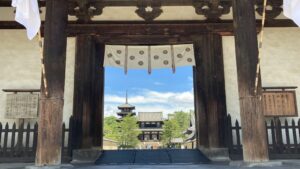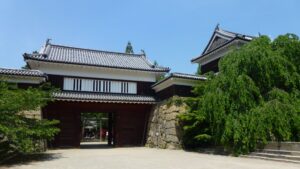Oda Nobunaga's Gifu Castle: After Countless Battles, the Dawn of Tenka Fubu
From the keep of Gifu Castle atop a rocky mountain, the Nagara River spreads out below, while the distant Japanese Alps and Kiso Ontake Mountains form a stunning natural backdrop. This region, Mino province (present-day Gifu), was a strategic crossroads where the Nakasendo, Hokurikudo, and Ise roads intersected, making it a vital transportation hub. It was also a major economic hub, closely linked to the timber-producing region, with the Nagara River's waterways. Along the river lay a fertile grain-producing region that contributed to the area's prosperous economy. When Oda Nobunaga took control of Gifu Castle, he renovated it extensively to create a place of refinement and hospitality. With his slogan Tenka Fubu (rule the realm through military force), he took the first steps towards restoring order to the war-torn era.

Inheriting the Oda Family Headship
Oda Nobunaga (織田信長:1534-1582) succeeded his father, Oda Nobuhide (織田信秀: 1510-1552), as head of the Oda family in April 1552, at the age of 19. Nobuhide was a renowned warrior known as the Tiger of Owari, but he fell ill and died at the age of 42. The young Nobunaga was suddenly thrust into the midst of battles against enemies. Over the next 14 years, he endured a relentless series of battles until he had subdued Owari Province, defeated the surrounding hostile forces, and finally taken control of Gifu Castle in 1567.
Owari Province (present-day western Aichi Prefecture) was officially under the control of the Shiba clan, who serverd as shugo daimyo (provincial military governors). The Shiba clan was a branch of the Ashikaga family and held authority in name only, as representatives of the Muromachi shogunate. In reality, true power in Owari lay with the Oda clan, who were retainers of the Shiba. The province was divided into two main regions: the Upper Four Districts in the north and the Lower Four Districts in the south. Each region was effectively ruled by a different branch of the Oda clan, acting as shugo-dai (deputy shugo). Oda Nobuhide, the father of Nobunaga, belonged to the southern branch known as the Oda Yamato-no-kami family, also known as the Kiyosu Oda clan. This family governed the Lower Four Districts. Nobuhide himself was the head of Oda Danjo-no-jo family, one of three magistrate families within the Kiyosu Oda clan.
Through a mix of military and political strategies, Nobuhide expanded his power and became one of the most influential warlords in Owari Province. In the process, he fought many battles against neighboring lords. These included Matsudaira Kiyoyasu, a grandfather of Tokugawa Ieyasu (1543-1616, 徳川家康), in Mikawa Province (present-day Okazaki) to the east, Imagawa Yoshimoto (1519-1560, 今川義元), ruler of Suruga and Totomi Provinces (present-day western Shizuoka Prefecture) also to the east, and the Saito Dosan (?-1556, 斎藤道三) to the north, who had taken control of Mino Province (present-day Gifu) by overthrowing his lord. Nobuhide also faced conflict within Owari Province. He came into open conflict with his overlord, the Oda Yamato-no-kami family.
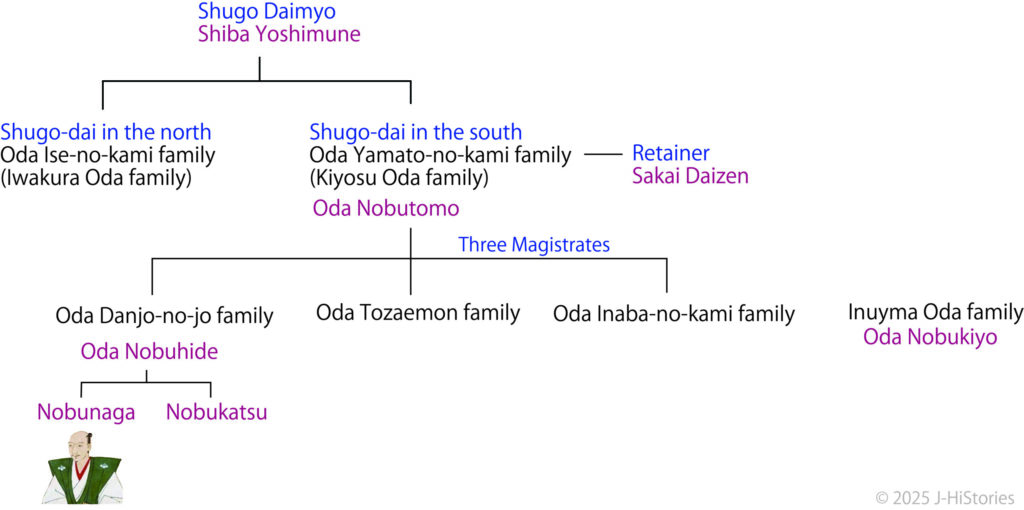
In 1549, Nobuhide, stricken with illness, was unable to defend Anjo Castle, defended by his illegitimate son Nobuhiro, from an attack by the powerful Imagawa Yoshimoto. Unable to lead his troops in person due to his condition, Nobuhide was left with no means to mount an effective response. Consequently, Nobuhiro was taken prisoner by the Imagawa. Despite the fall of Anjo Castle, Nobuhide remained bedridden and could not mobilize his army. Sensing this situation, the Imagawa forces invaded Owari Province the following year. Though the ailing Nobuhide managed to halt their advance, he was unable to take up arms, and the Imagawa forces remained in the southern Chita District until the end of the year. Under this tough situation, it was Shogun Ashikaga Yoshiteru who extended a hand. Through the shogun's mediation, a temporary peace was made between the Oda and Imagawa clans in 1551. However, Nobuhide's health condition worsened, and he passed away in March 1552 at the age of 42. Upon Nobuhide's death, many of his retainers and family members gave up on his heir, Oda Nobunaga, whom they had long derided as a O-utsuke (great fool). However, Nobunaga overcame a series of fierce battles and eventually gained control of Owari Province, around then, defeating his enemies in the surrounding provinces and moving his residence to Gifu Castle.
The Young Nobunaga's Ordeal: Rebellion and Betrayal Within
Shortly after Nobunaga succeeded his father, Nobuhide, as head of the Oda family, the first to rise in rebellion was Yamaguchi Noritsugu, one of Nobuhide's senior retainers. Noritsugu had been entrusted with the defense of Narumi Castle, strategically situated in the southeastern region of the Lower Four Districts, serving as a frontline stronghold against the Imagawa forces. However, Noritsugu defected, aligning himself with the Imagawa and turning his arms against Nobunaga. Nobunaga responded without delay, mobilizing his troops and marching to confront Noritsugu. The two forces clashed near Akatsuka (present-day Midori Ward in Nagoya City) where Noritsugu's forces were positioned. A fierce battle ensued, with volleys of arrows and the clash of spears, but the outcome remained undecided, and the fighting gradually subsided. This was Nobunaga's first battle after his succession to family headship.
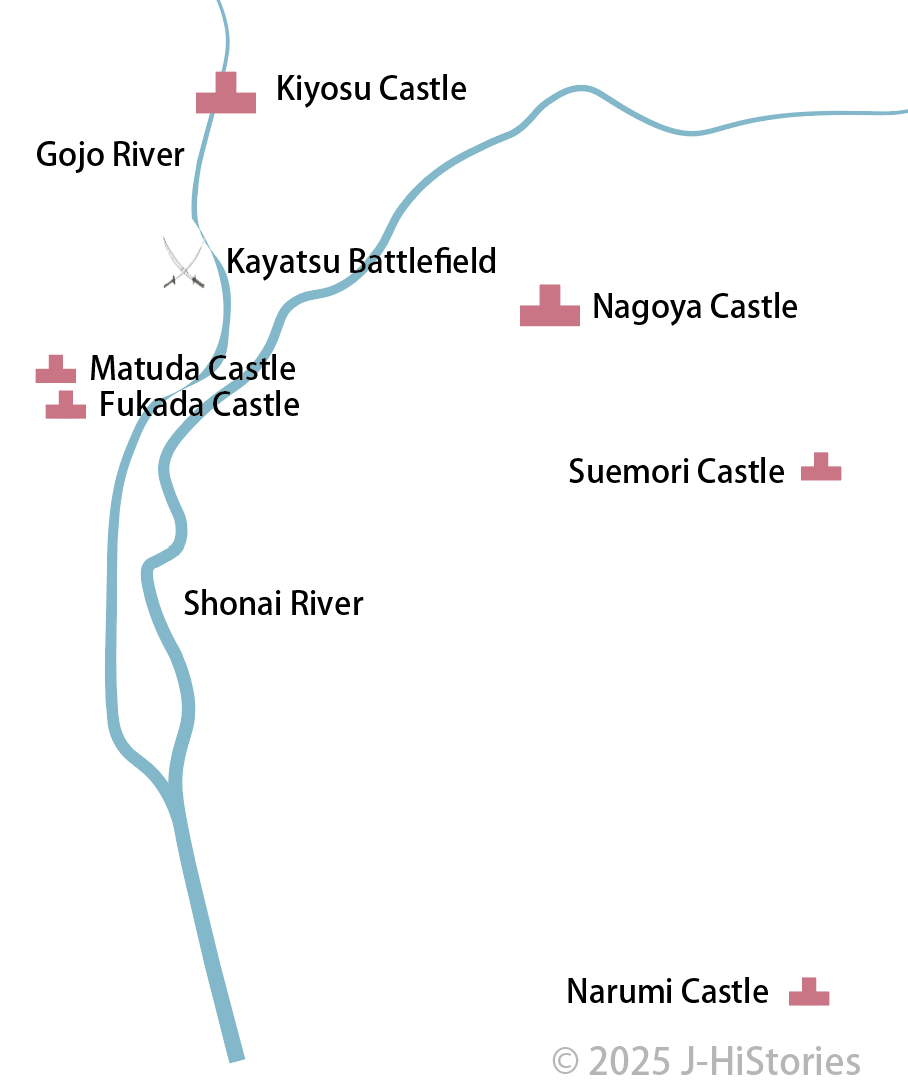
Just four months later, in August, another crisis broke out. Sakai Daizan and his son, senior retainers of Oda Nobutomo, the lord of Kiyosu Castle, took action. They launched a surprise attack on Matsuba Castle and Fukada Castle, both under Nobunaga's control. The assault succeeded: both castles were captured, and their lords were taken hostage. In response, Nobunaga divided his forces into three units and advanced toward Kiyosu, Matsuba, and Fukada Castles. The main force encountered Sakai Daizan's troops near Kayatsu (present-day, Ama City in Aichi Prefecture), where a fierce battle took place. Nobunaga emerged victorious and quickly retook both Matsuba and Fukada Castles. However, Sakai Daizen's ambitions did not end there. He conspired with his lord, Oda Nobutomo, and together they assassinated Shiba Yoshimune, the shugo daimyo of Owari Province. In response, Nobunaga, with a request for justice from Yoshimune's son, raised his forces once again. In 1555, he defeated Nobutomo. Sakai Daizen fled and sought asylum with the Imagawa clan. With this victory, Nobunaga finally secured control over the Lower Four Districts, which had been under the influence of the Kiyosu Oda clan. He was just 22 years old at the time.
In 1559, Nobunaga defeated the Iwakuwa Oda clan (also known as the Oda Ise-no-kami family), who served as shugo-dai in the northern part of Owari Province. He expelled their castle lord and brought their territory under his control. However, Nobunaga's unification of Owari would not be complete until 1565, when he subjugated the Inuyama Oda clan.
The Purge of Nobukatsu
Nobunaga took firm action to resolve internal strife within his family and succeeded in ending the power struggle inside the Oda Danjo-no-jo family. In 1556, his younger brother, Nobukatsu, rebelled. Known for his upright character, Nobukatsu gained the support of influential vassals, including senior retainers, as he began to plot to take Nobunaga's position as head of the family. Eventually, he took up arms against his brother. Nobunaga immediately responded. He confronted Nobukatsu's forces in battle. Outmatched by Nobunaga's troops, Nobukatsu fled to his residential Suemori Castle, where Nobunaga pursued and besieged the castle. However, after receiving a heartfelt request from their mother, Nobunaga decided to forgive Nobukatsu and also the senior retainers who had joined him. Even so, Nobukatsu did not abandon his opposition. In the end, Nobunaga decided to eliminate the threat completely. On November 2, 1558, he summoned Nobukatsu under the pretense of being ill and had him killed on the spot. At the time, the Oda family was surrounded by powerful enemies such as the Imagawa and Saito clans, who were looking for any opportunity to strike. In such a dangerous situation, Nobunaga chose to eliminate even his brother to remove any internal threats. He was 25 years old at the time.
The Battle of Okehazama: Nobunaga's Turning Point
While Nobunaga was busy unifying Owari Province, the powerful Imagawa army continued its invasion into Owari Province. After Narumi Castle fell, several nearby castles, including Odaka Castle (in Midori Ward, Nagoya City) and Kutsukake Castle (in Toyoake City), also fell into Imagawa hands. Additionally, the Imagawa forces built Muraki Fortress to cut off the communication between Nobunaga's forces stationed at Ogawa Castle and Chita Castle. Imagawa Yoshimoto, the head of the Imagawa clan, had taken control of the strategic coastal areas along the eastern shore of Ise Bay, aiming to dominate the sea routes in the region. For Nobunaga, whose economic power relied heavily on the ports of Tsushima and Atsuta, this posed an unacceptable threat. Thus, Nobunaga's counterattack began.
In 1554, Nobunaga captured Muraki Fortress. Then, he built Tange, Nakajima, and Zenshoji Forts around Narumi Castle, as well as Marune and Washizu Forts near Odaka Castle. These forts effectively cut off the supply routes for enemy troops and provisions, placing growing pressure on the Imagawa army. Tensions continued to rise. On June 12, 1560, Imagawa Yoshimoto led an army of 25,000 men out of Suruga and began a full-scale invasion of Owari. The next morning, after Yoshimoto entered Kutsukake Castle, the Imagawa army launched fierce attacks and captured both Marune and Washizu Forts surrounding Odaka Castle. Upon receiving news of the attack on the two forts, Nobunaga immediately danced Astumori while singing “The 50 years of the human realm, one of 6 realms of Buddhism, it’s too short to live”, and set out from Kiyosu Castle with only six cavalrymen. After praying for victory at Atsuta Jingu Shrine, Nobunaga advanced directly to Zenshoji Fortress and launched an attack during a thunderstorm on the Imagawa main camp at Okehazama. He defeated Imagawa Yoshimoto, whose army outnumbered his own ten to one, achieving a decisive victory. This battle made Nobunaga's name known throughout the nation. In addition to the weakening of the Imagawa clan, Nobunaga greatly reduced the threat from the east by allying with Matsudaira Nobuyasu of neighboring Mikawa Province—later known as Tokugawa Ieyasu. This Battle of Okehazama was, without a doubt, a turning point for Nobunaga. He was 28 years old at the time.
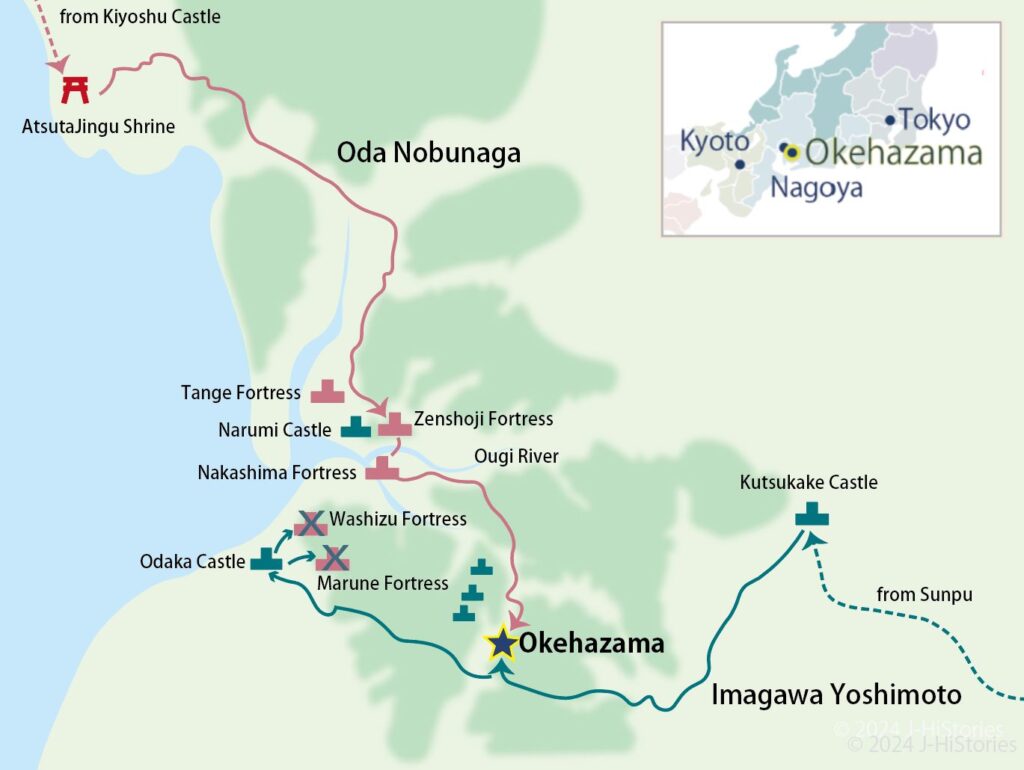
Conquest of Mino: The Great Cause of Tenka Fubu
In 1561, one year after the Battle of Okehazama, Saito Yoshitatsu, the ruler of Mino Province, died suddenly. His 14-year-old son, Saito Tatsuoki, inherited leadership of the Saito clan. Seeing this as an opportunity, Nobunaga launched a campaign into Mino. He departed from Kiyosu Castle, crossed the Kiso River, and invaded the province. The two armies clashed fiercely at Moribe (present-day Anpachi Town in Gifu Prefecture), and Nobunaga emerged victorious. He then advanced toward Inabayama Castle, the Saito clan's mountain stronghold. However, the castle's steep and fortified position proved too difficult to take, and Nobunaga was forced retreat
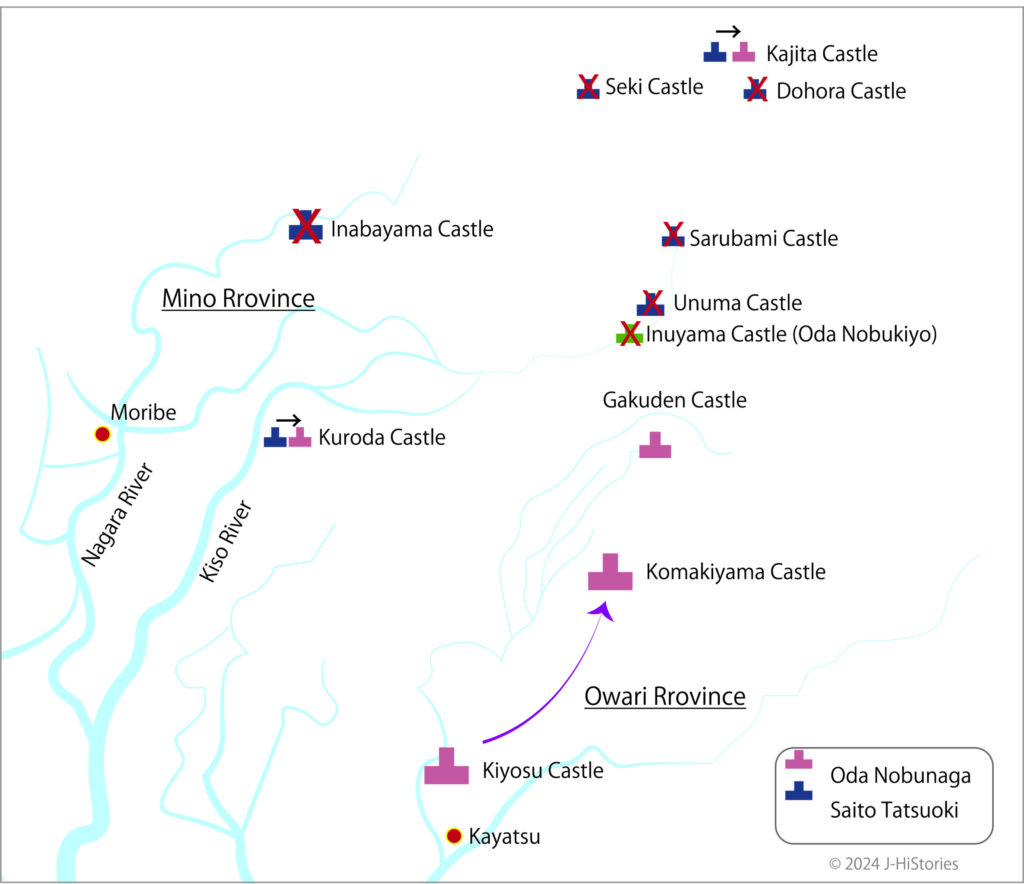
Therefore, in 1563, Nobunaga relocated his base to Mount Komaki and shifted his strategy. Instead of launching a direct assault on Saito's stronghold, he focused on subduing or capturing smaller outlying castles that remained loyal to the Saito clan. Around that time, internal unrest emerged within Owari Province. Oda Nobukiyo, lord of Inuyama Castle, rebelled against Nobunaga. However, the lord of Kuroda Castle, located near Komaki and defended by Nobukiyo's vassals, surrendered to Nobunaga. Inuyama Castle soon opened its gates. With this, by 1565, Nobunaga had finally secured complete control over Owari Province. That same year, Nobunaga formed an alliance with Takeda Shingen (1521-1573, 武田信玄) of Kai Province (present-day Yamanashi Prefecture), which bordered Owari Province, and, having established a solid foundation, pressed forward with his conquest of Mino Province.
The lord of Kajita Castle, who had been allied with the Saito clan, also switched sides and pledged loyalty to Nobunaga. Seizing the momentum, Nobunaga captured both Unuma Castle and Sarubami Castle, and then launched a major assault on the strategically important Dohora Castle. Under strong winds, Nobunaga ordered his soldiers to throw torches into the castle, setting fire to its second bailey. After the flames died down, he ordered the final assault. The battlefield became a chaotic melee where friend and foe were indistinguishable. Even so, Nobunaga's forces killed many enemy generals and captured Dohora Castle. Following this victory, three senior retainers of the Saito clan defected to Nobunaga. In 1567, Nobunaga finally succeeded in capturing Inabayama Castle, driving out its young lord, Saito Tatsuoki. With this, the seven-year campaign to conquer Mino Province came to an end. Among the warlords of the Sengoku period, Nobunaga stood out as a singular figure. He skillfully relocated his base of power following strategic needs, moving from Nagoya Castle to Kiyosu Castle, then to Komakiyama Castle, Gifu Castle, and later Azuchi Castle. This adaptive approach was one of the strategies he had learned from his father, Oda Nobuhide. Upon seizing Inabayama Castle, Nobunaga renamed the castle Gifu Castle and made it his base. From there, he began working to restore order throughout the Gokinai (five provinces including Kyoto and surroundings) under the authority of the Ashikaga shogunate. He also began proclaiming the great cause of Tenka Fubu, meaning bringing peace to the realm through military power. He was 34 years old.
The Grand Renovation of Gifu Castle
As soon as Nobunaga took control of Gifu Castle, he began a large-scale renovation of the castle. On the first floor, he built an elegant sitting room and a beautiful garden. On the third floor, he added a tea room. From the observation deck, visitors could look out over the entire castle town of Gifu, creating an impressive space for entertaining guests. One of the highlights was the guest house, which featured a grand garden carefully designed to incorporate the natural rock face of the mountain. This space reportedly left visitors in awe. Nobunaga welcomed cultural figures, nobles, and foreign missionaries to Gifu Castle, personally hosting them with warm hospitality. In 1568, he entertained Takeda Shingen's retainer with a sumptuous meal and showed a cormorant fishing event on the Nagara River. The next year, in 1569, he received Luís Fróis, a Jesuit missionary who had been granted permission to preach in Japan. Fróis described the buildings at the foot of the castle as a "palace" and expressed that the castle town seemed “like a paradise on earth.”
Around the same time, Yamashina Tokitsugu, a court noble and cultural figure who had previously visited Nobunaga's father, Nobuhide, stayed at Gifu Castle for about a month after being entertained by Nobunaga. The following year, he invited a renowned tea master, Tsuda Sokyu, from Sakai City, to hold a special tea ceremony. He served an elaborate meal that included dried persimmons, a local specialty from Mino. At that time, Nobunaga is said to have placed a branch of willow in his famous flower vase and placed it on the tray given to him by Sokyu. Nobunaga's hospitality extended far beyond luxurious cuisine and traditional Noh performances. He also prepared gifts for his guests. He did not rely solely on military power, but he also used cultural power to attract people, capture their hearts, deepen relationships, and expand his network of influence. This approach reflected Nobunaga's broader vision for realizing Tenka Fubu. Perhaps deep down, Nobunaga saw a reflection of his father, Nobuhide, in himself. Though known for his military strength, Nobuhide had also sought the counsel of court nobles and scholars from Kyoto. He had a tradition in high regard and had refined his skills in courtly arts such as Kemari (classical Japanese football), waka poetry, and etiquette.
Oda Nobunaga Timeline
| 1534 | Nobunaga is born in Owari Province | 1 |
| 1546 | Comes of age at Furuwatari Castle | 13 |
| 1552 | Inherits family leadership after father Nobuhide dies | 19 |
| 1552 | Wins the Battle of Akatsuka against Yamaguchi Noritsugu | 19 |
| 1552 | Wins the Battle of Kayatsu against Sakai Daizen | 19 |
| 1554 | Defeats Imagawa's Muraki Fort | 21 |
| 1555 | Takes control of Kiyosu branch of Oda clan | 22 |
| 1558 | Purges his brother Nobukatsu | 25 |
| 1558 | Defeats the Iwakura branch of the Oda clan | 25 |
| 1560 | Defeats Imagawa Yoshimoto at the Battle of Okehazama | 27 |
| 1561 | Wins the Battle of Moribe against Saito clan | 28 |
| 1561 | Attempts to capture Inabayama Castle from the Saito clan, but fails | 28 |
| 1563 | Moves to Komakiyama Castle | 30 |
| 1564 | Defeats the Iwakura branch of the Oda clan | 31 |
| 1565 | Captures Sarubami Castle from the Saito clan | 32 |
| 1565 | Defeats Dohora Castle from the Saito clan | 32 |
| 1567 | Captures Saito's residence, Inabayama Castle | 34 |
| 1567 | Moves to Inabayama Castle and renames it to Gifu Castle | 34 |
| 1567 | Proclaims the great cause of Tenka Fubu | 34 |
Recommendatoins to visit
Gifu Castle
- Access: 20 minutes from JR Nagoya Station to JR Gifu Station on the Tokaido Maine Line. Take a bus to the Gifukoen-mae stop. Take the Mount Kinka Ropeway.
Komakiyama Castle
- Access: 40-50 minutes from Nagoya Station to Komaki Station on the subway and Meitetsu Komaki Line. About 15 minutes to Komaki City Hall-mae bus stop.

